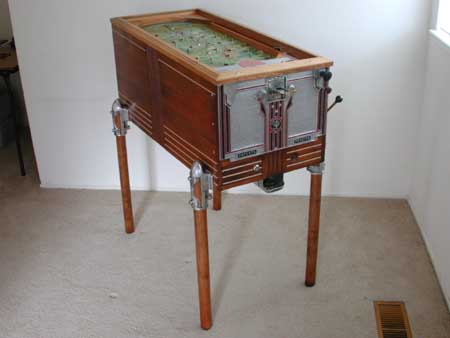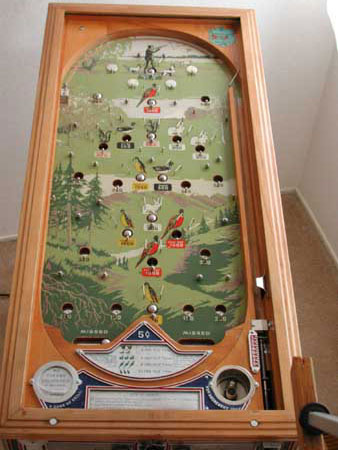Jennings Sportsman 1936

Jennings Sportsman: Slot Machine or Pinball?
Walk up to a Jennings Sportsman and take a quick look. It appears to be an older pinball machine with a ball shooter, pins on a playfield, and number values underneath the holes. Looks like a pinball. But wait! There is a slot machine lever on the side and a payout tray in the front! It must be a slot machine!
The game has an elegant appearance. The natural wood finish cabinet is perched on spindly legs, each leg held in place by beautiful polished castings. The front of the cabinet is a large polished casting, housing the coin slide, ball lift lever and shooter. Decoration consists of a hunter with his faithful dogs at the top of the playfield, along with a hole labeled “skill shot”. The rest of the holes have animals or birds above them, including pheasant, rabbits, ducks, quail, and squirrels.
The instruction card is held in another beautiful casting. It informs you that will get money if you get balls in all the holes of a particular animal, and you make the skill hole! Great, a pinball that pays out money! The more difficult the position and number of animals, the more money it pays out. Just pull the handle and money will come pouring out of the machine!
Is it a pinball or is a slot. Try playing it! That should help you decide. Put in your nickel or token and push in the coin slide. You get to shoot ten balls on to the playfield. Since the skill hole appears to be the most difficult and most important shot, try for it first. It is actually easy to make as there are few pins guarding it and a couple of wire channels to guide the ball into the hole. Imagine all the money you are going to take home today!
It proves to be difficult to get the balls into the same animal or bird and you have to put in a couple of nickels before you succeed in getting two balls in the two rabbit holes. Success! You also managed to make the skill hole, so you pull the lever and out comes three nickels. You are hooked. You play for three more hours. Unfortunately, it has 100 or your nickels and you are $5 down.
On one memorable occasion, you have a particularly good game. You mange to get the skill shot and all three quail. You pull the handle and get 60 cents. So far, so good. You still have six balls left and you gently nudge three more into the pheasant holes. You pull the handle and are rewarded with 45 more cents! This is really good! Then, in a masterful play of the game, you put your last balls into the three rabbit holes and a lever pull rewards you with six more nickels. That is a return of 27 nickels or $1.35. Not bad for a nickel investment. Let’s play some more!
Unfortunately there are some complications. There is a little ball on a tiny little pedestal. It will fall off if you nudge too much and then the game will not pay a winner. Worse, if you get a high paying winner, and then a low paying winner before you get the skill hole, you will only get the low paying winner payout.
You have to decide for yourself if this is a pinball or a slot. After playing it for a while, I decided it was more like a slot machine. It took my money and rarely paid out.

A Bit of History
Jennings started producing slot machines in 1920 and was the second largest producer after Mills. They continued to innovate and are known for adding a mint vendor to the slot machine in an attempt to disguise the gambling machine.
In 1929, Jennings also developed a method of separating checks or tokens from real money. Tokens were not “real” money and so the players were not “really” gambling. Slot machines were more exciting to play than pinball machines because the player might hit a jackpot.
Finally, in San Francisco (1933) and in New York (1934), the mayors started to wage war against all gambling equipment. It was clear to the slot machine manufacturers like Mills, Fey, and Jennings that the appearance of gambling needed to be avoided even though the machines were taking the player’s money. Adding skill to a game became important and so the payout pinball was developed.
Cliff Dumble designed the game in the summer of 1933. It required another year of development to perfect the payout mechanism. Handling money requires the machine to be reliable and to payout all winners. Many companies that manufactured payout pinball machines did not last because of problems handing the money and players being cheated.
According to Richard Bueschel in Pinball 1, "The original model was a fairly standard 18" x 38" playfield game with a deep boxy square-legged cabinet to hold its combination mechanical and electronic payout system. The most colorful feature is the playfield, a full field beautiful painting of a hunting scene."
He later describes the Improved Sportsman, "The IMPROVED SPORTSMAN of January 1935 cleaned up the game a great deal, with a completely new cabinet of "Deluxe Size 18-1/2" x 42" and lots of cast aluminum housings. The greatest physical improvement is a positive action payout lever at the side, eliminating missed payouts…"
Restoration
I restored two games for my client, serial numbers 5620 and 7722. I perform what I call “museum quality” restorations, where I try and preserve the original patina and functioning of the game but at the same time make it functionable. I also try and document the games for posterity by taking lots of pictures and writing articles.
There were surprising differences between the two games. 5620 has beautiful castings to hold the instruction and payout cards while 7722 only has them printed on silver paper. 7722 allows the operator to see the last coin played, preventing cheating, and 5620 does not. This difference results in changes in the front casting as well.
I rolled up my sleeves and started to work. I polished the wood cabinet, castings, and pins with their concentric springs. I waxed the playfield and checked the switch function under each hole. So far it was easy. I cleaned and rebuilt the coin slide and coin rejector. The game will take both tokens and real nickels. It sorts the real money into the cash box and only pays out with tokens. Greedy operators preferred the coin of the realm to tokens and so tokens were sorted into the payout tube.
Then I took a look at the payout mechanism. It was the only real electrical and mechanical part of the game, beyond the coin slide. It is very convoluted and confusing! The designers wanted to make sure that if you deserved some money you would get it but they also wanted to make sure you did not get a nickel more! There were many safeguards built into the mechanism, preventing the player from cheating.
The player can pull on the handle any time, however it is spring-loaded and will not activate the mechanism unless you have a winning combination. Even then, the balls in the holes activate a solenoid that raises a bar, impeding the progress beyond what you deserve, now matter how hard you pull. Pictures of the coin rejector, payout mechanism, and a sequence showing how it works are available on my web site in the mechanism section of www.sandsmuseum.com. The mechanism is a wonder all by itself.
I added a modern power supply to replace the original large batteries. The designers were careful to design the circuit so as to conserve the battery power. It only operates when the player pulls the handle, which is not often as they rarely win! The power is only used to release the lever as the player pulls it and to raise a gate limiting the amount paid out.
I also converted the operator’s manual to computer format in order to provide a copy for the second game. This article as well as one with more detail about the restoration process is included on The Sands Mechanical Museum web site.
Bibliography
Bueschel, Richard M.; Pinball 1, Illustrated Historical Guide to Pinball Machines, Volume 1; Hoflin Publishing Ltd; 1988
Thanks
I want to thank Ken Nerlove for letting me restore his games and for providing advice. Thanks also go to Dustin and Ryan for encouragement, testing, and scrounging nickels, and to my wife, Lynne, for the web animation technology and ideas.

